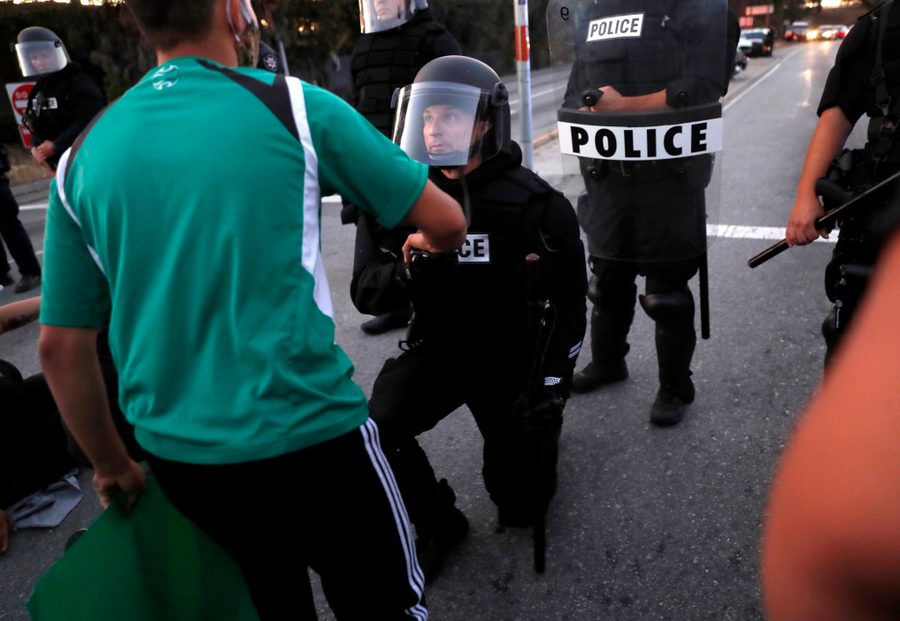Change the World and Watch Public Opinion Follow
How to stop letting our crises go to waste.
Hamilton Nolan

The work of political struggle goes on constantly, forever and ever, without end. True moments of opportunity, though, come about rarely and without warning. They cannot be manufactured; they can only be taken advantage of. The lulls between them — like right now — are the time to remember the lesson that we always seem to forget when things get interesting: Forget public opinion. Public opinion is a trap. Capture the structures when you have the chance.
In my adult lifetime there have been two great moments of opportunity for the Left. One was after the 2008 financial crisis, a period that you can generously construe as lasting several years, through the heyday of the Occupy movement. The other was in 2020, during the enormous national Black Lives Matter protests that broke out after the police murder of George Floyd. These events each had different causes and characteristics, but they had two key things in common. One, they were both moments in which public rage about injustice grew so intense that the institutions actually responsible for the injustices got scared and vulnerable. And two, that moment of vulnerability passed, and the intensity of rage ebbed, and before you knew it, the institutions of power had settled back into the status quo after offering mostly cosmetic changes. The windows of opportunity closed before we got around to throwing any grenades through them.
If you were alive and in the workforce in 2008, you will remember the fear. Regular people had fear of losing their jobs and their livelihoods as a result of Wall Street machinations that were barely understood, and Wall Street had fear of being tarred and feathered by mobs of angry peasants. The fears of the regular people turned out to be well founded. The fears of the financiers did not, although they were, for at least several months, so real that the practice of conspicuous consumption ground to a halt in Manhattan. People whose entire lives were dedicated to being seen as rich and powerful suddenly did not want to be recognized in public as being rich and powerful. Never before or since have I seen America’s anti-establishment rage get so palpable that it forced socialites to carry their luxury purchases in plain paper bags.
In 2020, America’s rage was directed at racism, and at the police. And the police were scared. In Minneapolis, the protesters burned down a police station, and the cops ran away. That moment was, for the people with guns, the same thing that 2008 was for the people with money: a strange, new “whoa now” experience that made them realize that the power arrangement they had always taken for granted was by no means guaranteed. That a backlash could be strong enough to knock them down.
And then? In each case, the snap back towards normalcy was fast enough to break necks. The federal government’s response to the 2008 financial crisis mostly focused on propping up the existing structure of Wall Street, rather than changing it. In 2020, it only took a few short months after the largest protest wave in American history for the Democrats to ostentatiously campaign against defunding the police.
The establishment knows what to do in these rare moments of peril: Say the right words, but leave the underlying structures alone. The official response whenever revolution looks somewhat likelier than usual is to soothe and sympathize and assure — to turn the temperature down, without letting anything catch on fire. Rather than tearing down the house, the powerful people just stuck their heads out the window and told the angry crowds that they were on their side. Barack Obama gave populist-sounding speeches about inequality, and Mitt Romney walked in the Black Lives Matter march, and then they went back and ensured that any changes more substantive than that did not happen.
The tragedy is not just that the voices of justified rage didn’t win. (That, after all, is something the Left is used to.) It is that these moments when the powerful actual feel the foundations of their power slipping beneath their feet represent leverage, and that leverage was squandered. Only rarely is the power structure scared enough to bargain away meaningful things. Wall Street banks would have acquiesced to real regulations if they had been pressed hard in 2008, because they weren’t in any position to refuse, and also they didn’t want to be pelted with bottles whenever they appeared in public. Police departments in 2020 could have been shrunk, and had their grotesque budgets reallocated, and been subjected to civilian oversight. Politicians in major cities could have done that, had they had the courage, and they would have had the support of all the people in the streets. The reason that neither of these things happened is that the anger of the public fell prey to the paralyzing sludge of bureaucratic inertia, like a runaway truck coasting to a stop in a long, muddy pit.
In very special times, radicals will have public opinion on their side. These times will not last. Focused and useful public outrage will inevitably dissipate, faster than we think. As soon as these very special times begin, we need to go directly for the structural change first. Before the press conferences and the DEI consultants and the panel discussions and the Big Mural of Social Justice Heroes sponsored by JPMorganChase, we need the substance. “Break up the banks” and “defund the police” are, contrary to conventional political wisdom, excellent goals, because both of them aim at dismantling the underlying structures that enabled things to get so out of hand in the first place. That is exactly why they are so ridiculed by those who might be charged with doing them. They don’t want to do that. Politicians want to pose on one knee while wearing kente cloths and paint “BLACK LIVES MATTER” in big letters down the middle of a street. That is easy. They don’t want to defund the police. That would be hard. After all of the marches and corporate symbolism and the “END RACISM” stickers affixed to NFL helmets, the Democratic Party is now poised to brand itself in 2024 as “tough on crime,” the very attitude that brought on overpolicing and mass incarceration in the first place. That the system will try to perpetuate itself is not a surprise. The question worth mulling over is, “Why do they get away with it?”
They get away with it because stalling, distraction and performative sympathy are tactics that work. We think to ourselves, “At last, public opinion on inequality is turning. At last, public opinion on police violence is turning. Soon it will turn definitively in our favor.” We mistake the pendulum of mainstream sentiment for a one-way road. But there is a simple heuristic that everyone on the Left can use to minimize the chances of falling into this trap in the future.
Instead of thinking of our goal as shaping public opinion, think of public opinion as something more like the weather — an outside force that we don’t control. Usually, the weather is bad. We spend that time inside, getting ready. And on the rare day when the weather is perfect — when, thanks to some unpredictable crisis, public opinion aligns with our goals — we run outside, plan in hand, and get everything we can get. Knowing that the nice weather won’t last, we go directly to the fundamental structures that need to be broken down and rebuilt. We focus on those things. We do not, under any circumstances, focus on public opinion itself. We do not spend these precious moments trying to magically extend the window of nice weather. We just do the work while the sun is out.
You don’t change the world by first convincing everyone you’re right. You seize the structures that produce the world, change the material reality and watch public opinion follow in the wake of the new world you’ve made. Temporary gains are for suckers. The next time the stalwarts of the system get scared, demand permanent changes immediately. Don’t settle for less. History tells us that their fear will always ebb. The only question is whether you knocked down their fortress in the meantime.
Hamilton Nolan is a labor writer for In These Times. He has spent the past decade writing about labor and politics for Gawker, Splinter, The Guardian, and elsewhere. More of his work is on Substack.








